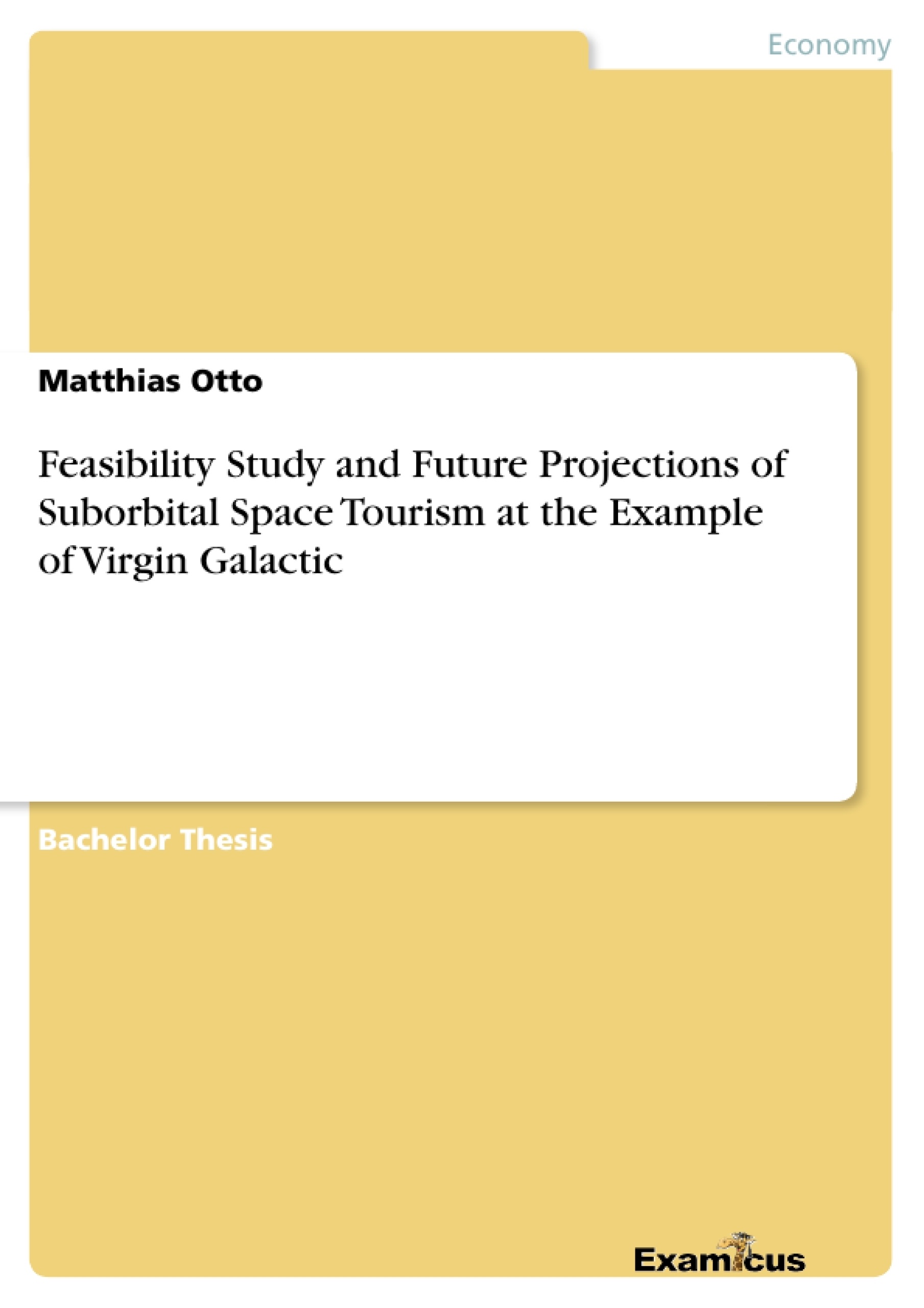Die Arbeit "Feasibility Study and Future Projections of Suborbital Space Tourism at the Example of Virgin Galactic" beschäftigt sich mit dem Thema Weltraumtourismus, insbesondere mit dem so genannten suborbitalen Weltraumtourismus - ein gegenwärtig bei Privatunternehmen zu beobachtender Trend, die kommerzielle Flüge bis zur Grenze zum Weltall anbieten. Diese Grenze, nach ihrem Entdecker Theodore von Karman "Karman Line" benannt, befindet sich laut der FAI (Fédération Aéronautique Internationale) in einer Höhe von etwa 100 km. Der Verfasser führt am Beispiel des angloamerikanischen Unternehmens Virgin Galactic eine detaillierte Machbarkeitsstudie zu diesem Phänomen durch und stellt, basierend auf den Ergebnissen dieser Studie, Zukunftsprognosen auf. Nach einer generellen Einführung in das Thema (u.a. Geschichte, Beweggründe für einen Weltraumflug, Stufen des Weltraumtourismus), widmet sich der Verfasser den Schwerpunkten der Machbarkeitsstudie. Hierbei handelt es sich im Einzelnen um eine Analyse der Vorgehensweise von Virgin Galactic und den vielversprechendsten Konkurrenten (Space Adventures, Benson Space Company, Space Access, Incredible Adventures, Rocketplane Limited, Starchaser Industries, und Blue Origin), sowie um eine Analyse der Weltraumflugschiffe und deren Hersteller. Anschließend wird der gesetzliche Rahmen am Beispiel der FAA (Federal Aviation Administration) dargestellt und es werden Ergebnisse aus Marktforschungsprojekten ausgewertet, um die Nachfrage für suborbitale Flüge zu erklären. Die Arbeit kommt zu dem Ergebnis, dass sich die Industrie zwar noch in einem Anfangsstadium befindet, aber trotzdem ein enormes Wachstumspotential aufweist.
Inhaltsverzeichnis (Table of Contents)
- 1. Introduction
- 2. General Aspects on Space Tourism
- 2.1 History of Space Exploration and Space Tourism
- 2.2 Motives for going to space
- 2.3 Benefits of Space Tourism
- 2.4 Obstacles to Space Tourism
- 2.5 Stages of Space Tourism
- 3. Feasibility Study and Future Projections of Suborbital Space Tourism
- 3.1 The Virgin Galactic Approach
- 3.1.1 The Product
- 3.1.2 The Place
- 3.1.3 The Communication Policy
- 3.1.4 SWOT Analysis of Virgin Galactic
- 3.2 Analysis of Virgin Galactic’s Direct Competitors in Suborbital Space Tourism
- 3.2.1 Space Adventures
- 3.2.2 Benson Space Company
- 3.2.3 Space Access
- 3.2.4 Incredible Adventures
- 3.2.5 Rocketplane Limited
- 3.2.6 Starchaser Industries
- 3.2.7 Blue Origin
- 3.2.8 Summary
- 3.3 Suborbital Reusable Launch Vehicles and Their Manufacturers
- 3.3.1 SpaceShipTwo (The Spaceship Company)
- 3.3.2 Dream Chaser (SpaceDev)
- 3.3.3 New Shepard (Blue Origin)
- 3.3.4 Skyhopper (Space Access)
- 3.3.5 Newson’s Spaceship (EADS Astrium)
- 3.3.6 Lynx (XCOR Aerospace)
- 3.3.7 Ascender (Bristol Spaceplanes)
- 3.3.8 Thunderstar (Starchaser Industries)
- 3.3.9 Rocketplane XP (Rocketplane Limited)
- 3.3.10 Summary
- 3.4 Regulatory Framework and Non-Profit Space Tourism Organisations
- 3.4.1 Federal Aviation Administration (FAA)
- 3.4.2 X Prize Foundation
- 3.4.3 Space Tourism Society
- 3.4.4 Summary
- 3.5 Suborbital Space Tourism Demand
- 3.1 The Virgin Galactic Approach
Zielsetzung und Themenschwerpunkte (Objectives and Key Themes)
This thesis analyzes the feasibility and future projections of suborbital space tourism, using Virgin Galactic as a case study. The core objective is to evaluate whether suborbital space tourism can become a viable and profitable industry in the near future.
- Feasibility of suborbital space tourism as a commercial venture.
- Analysis of the competitive landscape within the suborbital space tourism market.
- Assessment of the technological readiness of reusable launch vehicles.
- Examination of the regulatory framework and its impact on the industry.
- Evaluation of the existing and projected demand for suborbital space flights.
Zusammenfassung der Kapitel (Chapter Summaries)
Chapter 1: Introduction introduces the topic of space tourism and outlines the thesis's research question and methodology. Chapter 2: General Aspects on Space Tourism provides a historical overview of space exploration and tourism, explores the motivations for space travel, discusses the benefits and obstacles, and details the various stages of space tourism.
Chapter 3: Feasibility Study and Future Projections of Suborbital Space Tourism comprises the main body of the thesis, examining Virgin Galactic's approach, its competitors, reusable launch vehicles, the regulatory environment, and the market demand. This section analyzes Virgin Galactic's business strategy, including its product, location strategy, and communication policy.
- Quote paper
- Matthias Otto (Author), 2008, Feasibility Study and Future Projections of Suborbital Space Tourism at the Example of Virgin Galactic, Munich, GRIN Verlag, https://www.grin.com/document/186729



